This devastating disease wreaks terrible havoc on the body. It leads to meningitis, personality changes, mental illness, or inflammation of the arteries. It forms hideous sores on the skin. The cartilage in the nose collapses. But not everyone is discouraged. Who wanted to get sick… and why?
Syphilis is quite pleasant to catch. And surprisingly easy - not only through vaginal or anal intercourse, but also oral caresses or even ... a kiss with a tongue. It starts innocently:with a small, round lump on the skin and enlarged lymph nodes. The problem "disappears" after three weeks, but soon a mild rash and gray-white, wet lesions appear on the skin. The lymph nodes are enlarging again and other ailments slowly appear:sore throat, fever, lack of appetite, and sometimes meningitis.
If the patient does not start treatment, syphilis inexorably, though often imperceptibly at first, devastates the body. It most often attacks the nervous and circulatory systems. And the slow decay begins ... Sounds disgusting? And yet, although it is hard to believe today, there have been cases of infected people who are happy because of their illness. At least until it is fully developed…
Hallelujah! I have a crap!
One of the satisfied "buyers" of syphilis was French naturalist and decadent writer Guy de Maupassant. Upon hearing of his illness, he triumphantly wrote to his friend:
I have a crap, but a real one, not some clapper, not sanctimonious troubles, non-bourgeois genitalia, not bland water veggies, no, no! This is a real, big mess that Francis I died of. I am proud of it and I despise all bourgeoisie. Alleluia! I have a crap!
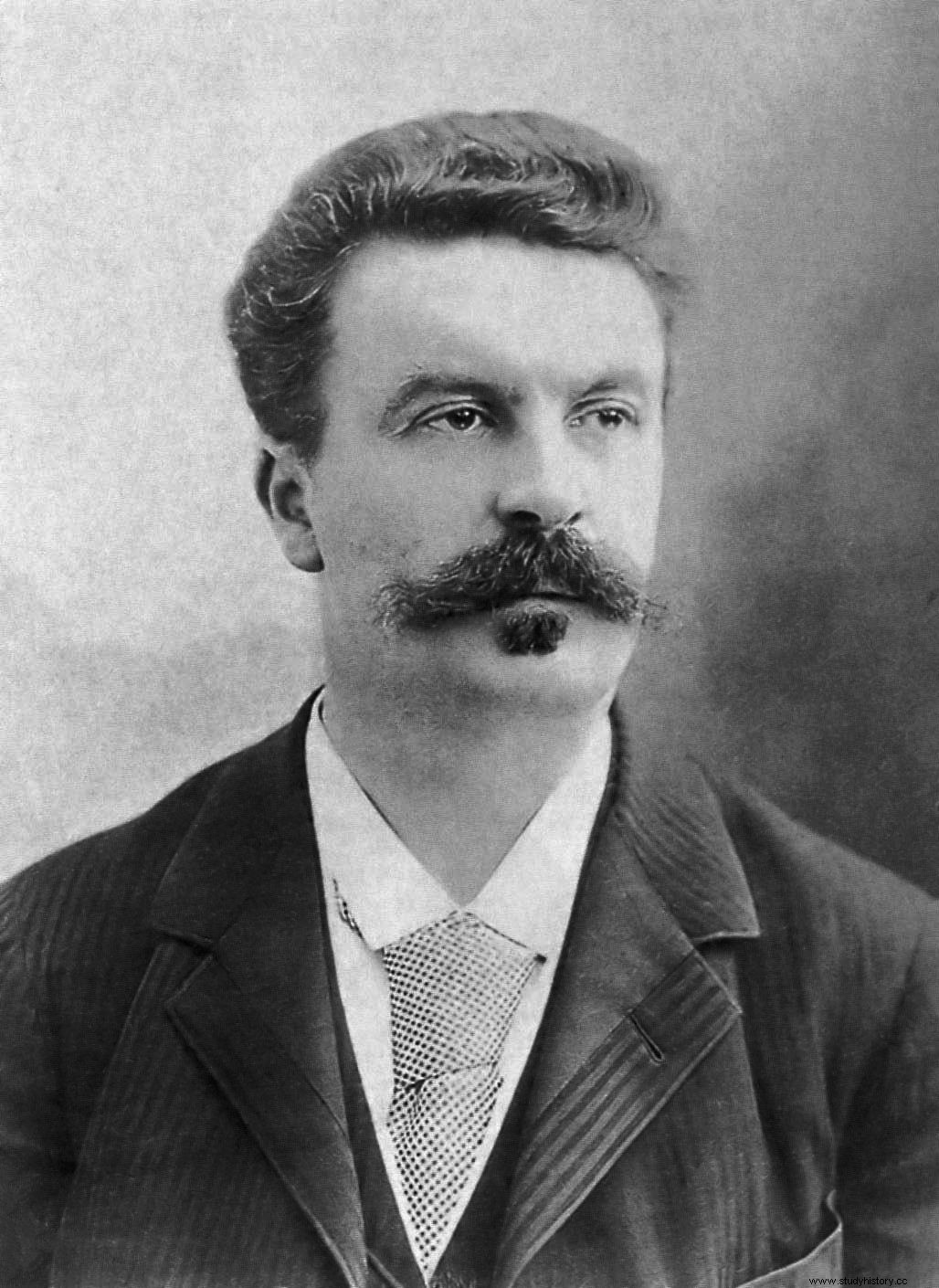
"Alleluia! I have a shit ”- said Guy de Maupassant at the news of his illness. He was proud to be struggling with syphilis, not with some "sanctimonious troubles" (photo by Félix Nadar, source:public domain).
In fact, the writer dreamed of syphilis for a long time. Once upon a time he even painted a penis ulcer, showed it to his friend and then raped her to give her the impression of your "happiness". In fact, he was not alone in this particular fascination. One of the greatest masters of French literature, Gustave Flaubert, also enjoyed his illness, writing in a letter to his friend:
So you were laughing, old bastard, perfidious guy at my unfortunate sword. Well, know that I'm cured for the time being. Only a slight hardening remains, but it is the hero's scar. This makes him poetry.
It destroys the body, strengthens the sensations
There were more painters, writers and poets infected with syphilis. Among others, Gustav Klimt, Henri de Toulouse-Lautrec, Vincent van Gogh and Charles Baudelaire were ill. Friedrich Nietzsche, Oscar Wilde, Paul Gauguin and Karen Blixen also suffered from syphilis. Polish artists - Kazimierz Przerwa-Tetmajer and Stanisław Wyspiański also knew it. The latter got infected in Krakow, with a printing house worker ... or in Paris, with a Javanese model and Gauguin's mistress.

The article was based, among others, on the book “W oparach absinttu. Scandals of Young Poland ”by Iwona Kienzler (Bellona 2017).
Interestingly, the news of the infection was not always received with fear. This is what Iwona Kienzler writes about the reactions of bohemian artists in her book W oparach absinttu. Scandals of Young Poland ”:
The members of the bohemia of the time did not treat this disease as a divine act, although in those days spirochete infection was tantamount to a death sentence. It just so happens that syphilis, by invading the brain, simultaneously activates its cells, causing in the infected person almost unearthly visions and delusions .
Therefore, not only amateurs of paid love suffered from the "sickness of whores", as syphilis was often called, but most artists who contracted the disease on purpose in order to exceed the limitations of them through their own mind, and even move into new, unknown dimensions. In short, syphilis was, in a way, a substitute for modern drugs that are now used by various authors.
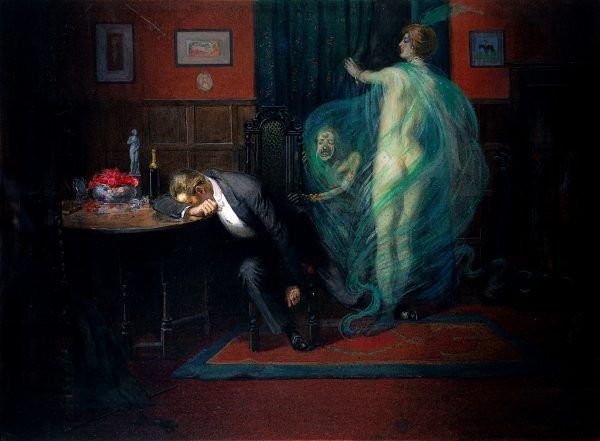
Syphilis, pictorially portrayed in Richard Cooper's painting, has seldom been welcomed. Some artists, however, treated him ... as a source of additional experiences (photo:Wellcome Images, license CC BY 4.0).
The concept that syphilis destroys the body, but increases sensations, appeared at the end of the 16th century in Spain. It was developed two centuries later by the French writer Léon Daudet. This disease, he wrote, is as well a whip stimulating genius and talent, heroism and spirit, as well as general paralysis. And he explained that it contributes to development: He makes a great poet out of the son of a servant, out of a quiet petty bourgeois - a satire, out of a sailor - an astronomer or a conqueror .
However, the price for an artistically stimulating "boost" was terrible. But most of his admirers did not find out about it until later. Wyspiański's last self-portrait shows how much the disease destroys the body. The artist was drawing it with a barely skilled hand, bandaged to a piece of board. By this stage he was breathing hard and he could only eat chopped food . Syphilis was the cause of his premature death.
Is there anything worse than syphilis?
Not only artists enjoyed syphilis. The soldiers were also happy with the infection. But for completely different reasons. Those who did not want to wear boots were exempted from conscription by the disease. And later, when Belle époque ended with the outbreak of World War I, venereal diseases became the best excuse to escape the nightmare of fighting for a while. Self-shooting was another solution. However, they were punished by a court martial, while syphilis gave the war heroes and decoilers the longed-for hospital bed. And soon the ranks of much needed soldiers at the front began to shrink dangerously.
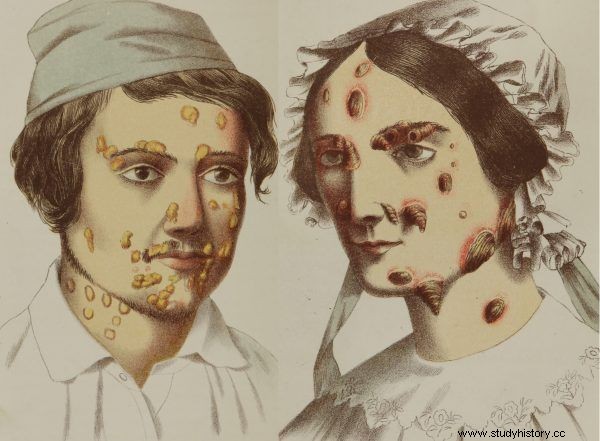
Untreated syphilis was accompanied by the appearance of ulcers from which the secretion was oozing. This is how the disease was presented in the mid-nineteenth century by the authors of the book "A treatise on gonorrhoea and syphilis", Silas Durkee and John S. Parry (source:public domain).
Peter Englund described in the book "The Beauty and the Sorrow of War" the determination of soldiers to catch venereal disease. It happened that they were not only looking for sick prostitutes, but also traded oil from gonorrhea patients ; soldiers bought her and then rubbed her genitals, hoping to end up in the hospital.
Since each median duration of venereal disease treatment in the hospital lasted 6 weeks, for each soldier infected with it, it meant as much as a month and a half quiet in the rear. Those who wanted complete release from the army rubbed their eyes with oil for better effect. The price for this, however, was… loss of sight.
During World War I, over 416,000 cases of the disease were cured only in British soldiers. The statistics in other armies were no better. The attempts made by the commands to maintain the combat capability of their subordinates gave little. In order to reduce the incidence of the disease, condoms were distributed, licensed brothels were run, and sick prostitutes were sent for compulsory treatment.
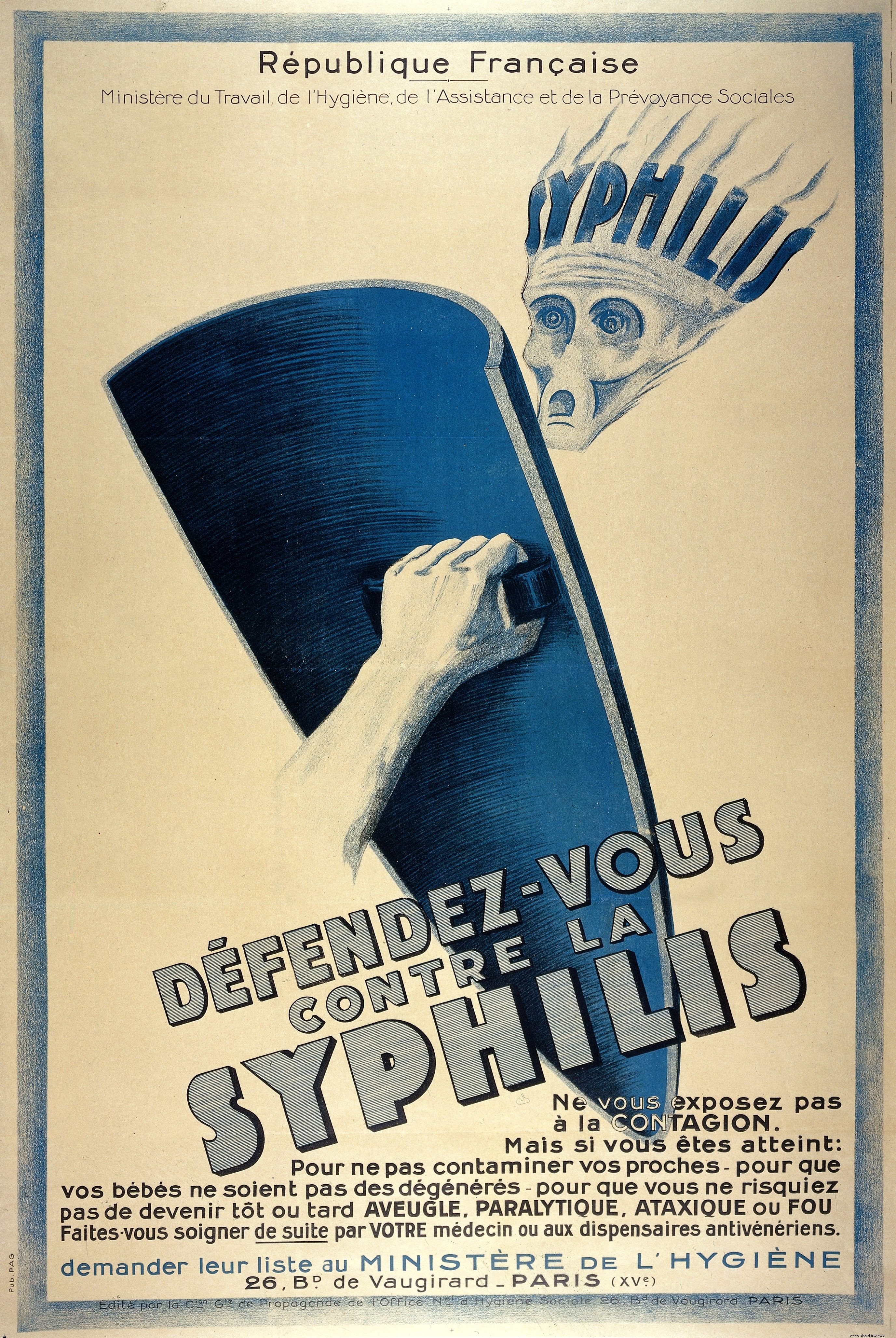
Before the First World War, French authorities called for protection against syphilis (photo:Wellcome Images, license CC BY 4.0).
The microbes were getting the better. As early as 1914, the tsarist army realized that the number of beds that the Russian army had ordered for its wounded and sick was barely enough for ... patients suffering from venereal diseases. No wonder one of the French doctors even described the prostitutes as a spiral machine gun .
Syphilis, Hitler's ally?
Venereal diseases kept commanders awake at night not only during World War I. In the 18th century, the British army in India was losing 30-37 percent of the state because of them! At the same time, the Prussian officers who got into trouble had a problem with healing even light wounds. The condition of the French army, which in 1849 crushed the revolution in Rome and began to occupy the city, was vividly described by the poet Teophlile Gautier:
The entire French army is under attack:kilaki explode like grenades in their groins, gonorrhea squirts with purulent urine streams and competes with the fountains in piazza Navona fissures and condylomas hang with purple fringes from the backs of sappers, entrenched in their foundations, growths peel off their tibias, as if from mossy columns in Roman ruins.

The article was based, among others, on the book “W oparach absinttu. Scandals of Young Poland ”by Iwona Kienzler (Bellona 2017).
The staff walks with their arms starry by the constellations of pimples, you can see lieutenants walking on the streets, stained, speckled like leopards, due to rashes, freckles, coffee-colored stains , papillary growths, cone-shaped and cryptosexual appendages and other secondary and tertiary symptoms that appear here after fifteen days.
Syphilis also "supported" the German offensive against France during World War II. He did so by weakening Maurice Gamelin in command of the French army. Despite the effective treatment, the general still had mental dullness, loss of concentration, memory impairment and inability to correctly assess the situation. The problem on a shocking scale also concerned the soldiers on the Italian front in 1945. For every thousand of them, 9 people died or were injured, and 68 - were unfit for service due to venereal diseases ...
Even worse, the number of the wounded and killed and infected looked like two years earlier in Burma. It was 13 and 157 respectively. Condoms saved the situation a bit, although sometimes you had to resort to trickery to even be able to order them for soldiers. The US Army, in order to avoid accusations of promoting debauchery, ordered them officially as necessary to protect the barrels of machine guns from moisture .
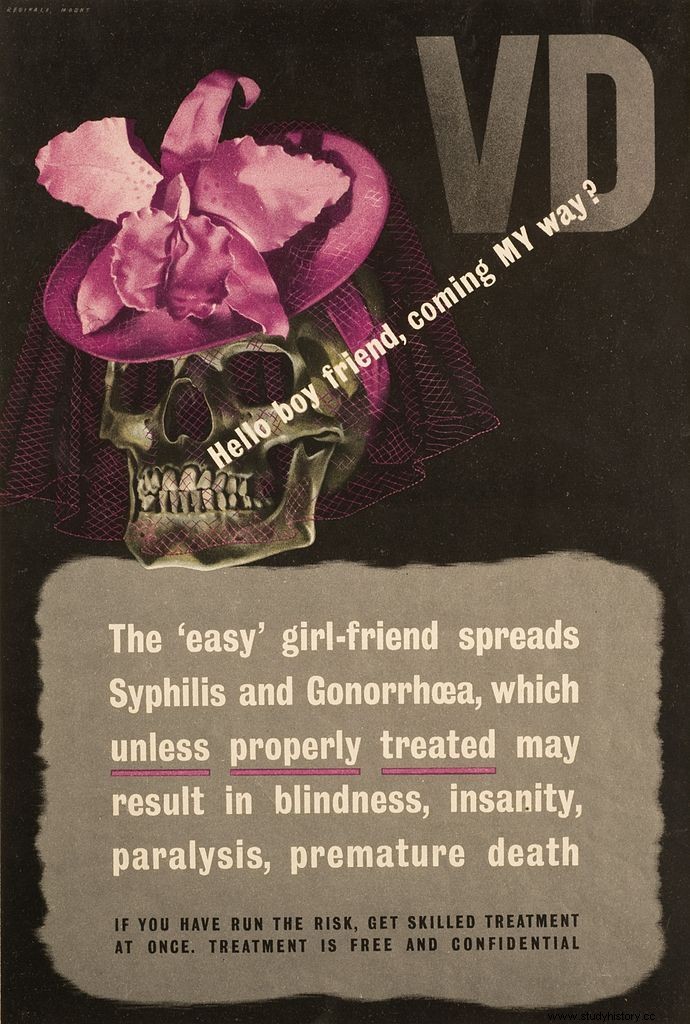
During World War II, numerous posters informed soldiers about the possible consequences of developing syphilis and gonorrhea. Above, an English poster from around 1943-1944 (photo:Wellcome Images, license CC BY 4.0).
Syphilis like a thin black snake
The dubious "career" of syphilis faded with the end of World War I. The German writer Erich Maria Remarque described the disease figuratively: Syphilis - a hideous word that hisses like a thin black snake. The disease was an embarrassment. There were times when a dermatologist in a small town would not dare to bow first to his patient in public so as not to expose him to gossip. So obsessed was the sister of French writer Julian Green that she read syphilis books only wearing gloves.
The awareness of the consequences of developing syphilis was spreading. Dermatology clinics, brochures, posters, articles, broadcasts and films have appeared all over Europe. The French threatened young people with the fact that venereal diseases killed 150,000 of their compatriots each year. They added figuratively: This was the balance of the battle of the Marne or the Charleroi .
There were also tips on how to protect yourself against infection. For example, the French suggested that in romantic circumstances, while admiring the face of the chosen one, glance at her lips, gums and tongue. They urged that while admiring her breasts, examine the skin beneath them, looking for spots.
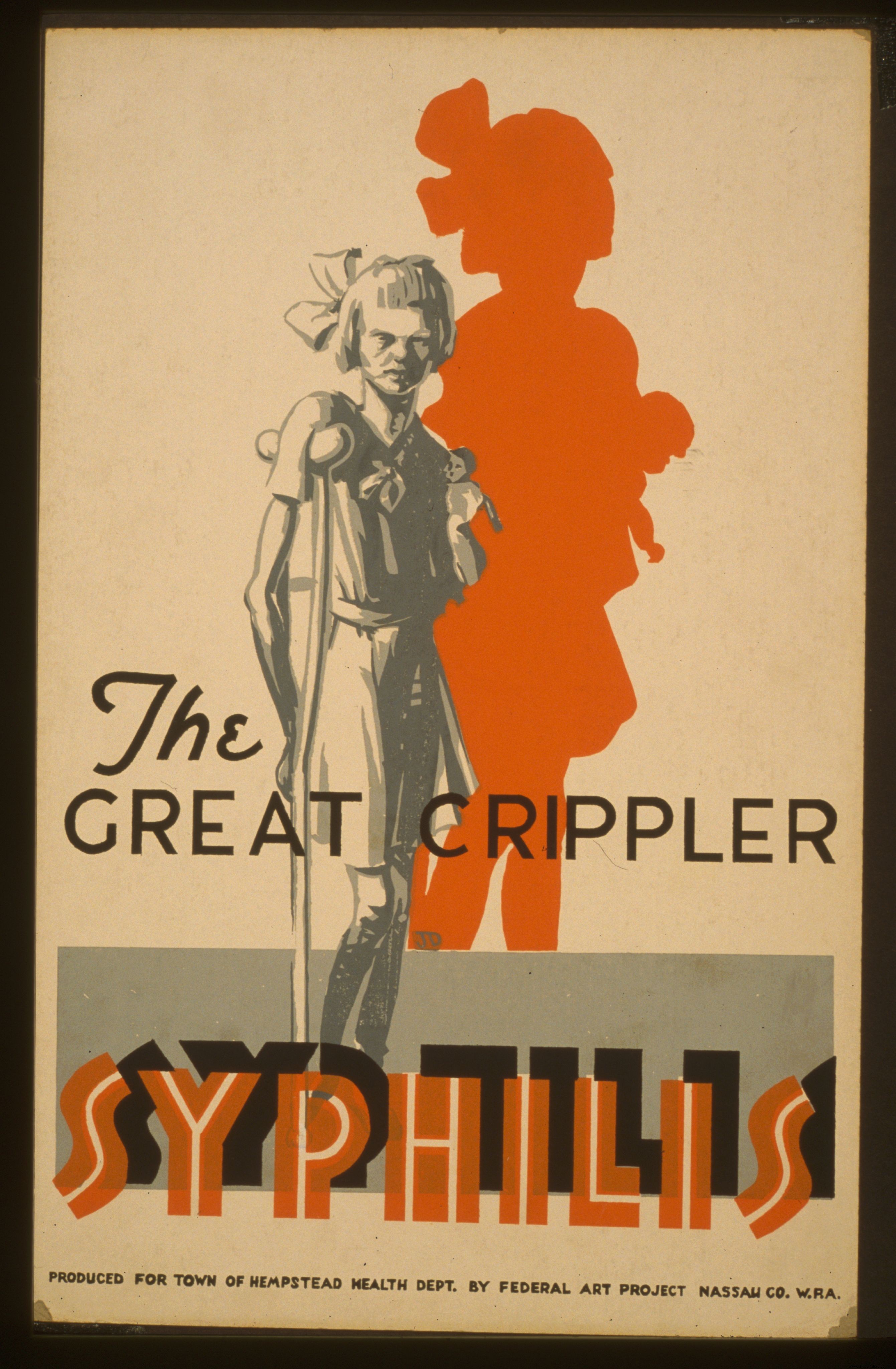
In the interwar period, governments warned against the effects of syphilis by all means, encouraging them to start treatment as soon as possible. The poster above was commissioned by the Hempstead Department of Health (source:public domain).
It was also necessary to properly protect oneself against proceeding to further actions. This meant, first of all, checking that at the gate there were no tigers and snakes in the form of ulcers or purulent discharge. French authors also encouraged to shorten the time of pleasure, because [longer] stay is dangerous, and avoiding kisses on the lips with random people. After all, you can always excuse yourself with disgust with the taste of lipstick ...
Good advice did not always help. The Polish socialist "Głos Kobiet" on February 20, 1938 reported that during this period almost every 20th person in the world was venereally ill . The breakthrough in combating it was the invention of penicillin.
Bibliography:
- Peter Englund, The beauty and sorrow of war. Twenty extraordinary fates from the time of the global conflagration , Trans. Emilia Fabisiak, Znak 2011.
- Kamil Janicki, Brothels on wheels. Paid love in the heat of war, Historical Curiosities November 10, 2011
- Kamil Janicki, The epoch of hypocrisy. Sex and erotica in pre-war Poland , Mark 2015.
- Iwona Kienzler, In the mist of absinthe. Scandals of Young Poland , Bellona 2017.
- Józef Krzyk, Neapolitan disease, French ... just syphilis , "Ale Historia", supplement to "Gazeta Wyborcza" on 7 September 2012
- Ewa Lando, Everyone was afraid of something. Phobias, fears and complexes of great Polish women and Poles , Wydawnictwo Czerwony i Czarne 2016.
- Claude Quétel, Impotence from Naples, or the story of syphilis , trans. Zofia Podgórska-Klawe, National Institute for them. Ossoliński 1991.
- Geoffrey Regan, Military Errors , trans. Konrad Gocman, Vasco International 1992.
- "The Voice of Women" No. 4, February 20, 1938.
Check where to buy:“In the mist of absinthe. Scandals of Young Poland ”:
